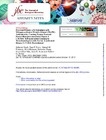| dc.contributor.creator | Stack, Julianne | |
| dc.contributor.creator | Hurst, Tara P. | |
| dc.contributor.creator | Flannery, Sinead M. | |
| dc.contributor.creator | Brennan, Kiva | |
| dc.contributor.creator | Rupp, Sebastian | |
| dc.contributor.creator | Oda, Shun-ichiro | |
| dc.contributor.creator | Khan, Amir R. | |
| dc.contributor.creator | Bowie, Andrew G. | |
| dc.date.accessioned | 2019-02-26T14:33:57Z | |
| dc.date.available | 2019-02-26T14:33:57Z | |
| dc.date.issued | 2013 | |
| dc.identifier.citation | Stack, J. et al. Poxviral protein A52 stimulates p38 Mitogen-Activated Protein Kinase (MAPK) activation by causing tumor necrosis factor receptor-associated factor 6 (TRAF6) self-association leading to transforming growth factor b-activated kinase 1 (TAK1) recruitment. J. Biol. Chem. 2013, 288(47):33642-53. | en_US |
| dc.identifier.uri | http://hdl.handle.net/10395/2681 | |
| dc.description | Poxviral protein A52 stimulates p38 Mitogen-Activated Protein Kinase (MAPK) activation by causing tumor necrosis factor receptor-associated factor 6 (TRAF6) self-association leading to transforming growth factor b-activated kinase 1 (TAK1) recruitment. | en_US |
| dc.description.abstract | Vaccinia virus encodes a number of proteins that inhibit and manipulate innate immune signaling pathways that also have a
role in virulence. These include A52, a protein shown to inhibit IL-1- and Toll-like receptor-stimulated NF B activation, via
interaction with interleukin-1 receptor-associated kinase 2 (IRAK2). Interestingly, A52 was also found to activate p38 MAPK and thus enhance Toll-like receptor-dependent IL-10 induction, which was TRAF6-dependent, but the manner in which A52 manipulates TRAF6 to stimulate p38 activation was unclear. Here, we show that A52 has a non-canonical TRAF6- binding motif that is essential for TRAF6 binding and p38 activation but dispensable for NF B inhibition and IRAK2 interaction. Wild-type A52, but not a mutant defective in p38 activation and TRAF6 binding (F154A), caused TRAF6 oligomerization and subsequent TRAF6-TAK1 association. The crystal structure of A52 shows that it adopts a Bcl2-like fold and exists as a dimer in solution. Residue Met-65 was identified as being located in the A52 dimer interface, and consistent with that, A52-M65E was impaired in its ability to dimerize. A52-M65E although capable of interacting with TRAF6, was unable to cause either TRAF6 self-association, induce the TRAF6-TAK1 association, or activate p38 MAPK. The results suggest that an A52 dimer causes TRAF6 self-association, leading to TAK1 recruitment and p38 activation. This reveals a molecular mechanism whereby poxviruses manipulate TRAF6 to activate
MAPKs (which can be proviral) without stimulating antiviral NF B activation. | en_US |
| dc.language.iso | eng | en_US |
| dc.publisher | ASBMB [American Society for Biochemistry and Molecular Biology] | en_US |
| dc.relation.ispartofseries | 288;47 | |
| dc.rights.uri | http://www.jbc.org/content/288/47/33642.long | en_US |
| dc.subject | Poxviral protein | en_US |
| dc.subject | A52 | en_US |
| dc.subject | p38 | en_US |
| dc.subject | Mitogen-Activated Protein Kinase (MAPK) | en_US |
| dc.subject | Tumor necrosis factor receptor-associated factor 6 (TRAF6) | en_US |
| dc.subject | Transforming growth factor b-activated kinase 1 (TAK1) | en_US |
| dc.subject | Recruitment | en_US |
| dc.subject | Growth | en_US |
| dc.title | Poxviral protein A52 stimulates p38 Mitogen-Activated Protein Kinase (MAPK) activation by causing tumor necrosis factor receptor-associated factor 6 (TRAF6) self-association leading to transforming growth factor b-activated kinase 1 (TAK1) recruitment | en_US |
| dc.type | Article | en_US |
| dc.type.supercollection | all_mic_research | en_US |
| dc.type.supercollection | mic_published_reviewed | en_US |
| dc.description.version | Yes | en_US |
| dc.identifier.doi | 10.1074/jbc.M113.485490 | |


